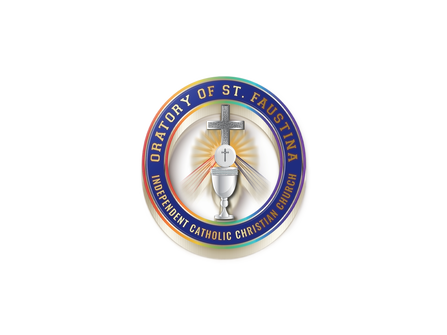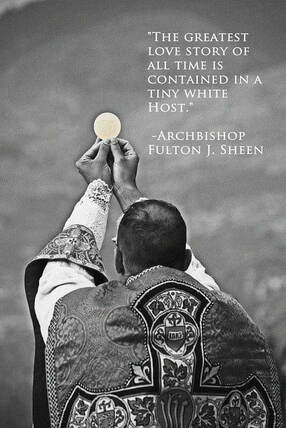Join us Sunday @ 10:00 am eastern time
The Mass used at the Oratory is taken from The English Missal, also sometimes called the Knott Missal. The English Missal is a translation of the pre Vatican II Roman Missal used by some Anglo-Catholic churches. After its publication by W. Knott & Son Limited in 1912, The English Missal was rapidly endorsed by the growing Ritualist movement of Anglo-Catholic clergy, The translation of the Roman Missal from Latin into the stylized Elizabethan Early Modern English of the Book of Common Prayer allowed clergy to preserve the use of the vernacular language while adopting the Roman Catholic texts and liturgical rubrics. The English Missal went through five editions. The first three were based on the Roman Missal of Pius V as revised until the time of Pius X. The latter two editions include the revised Roman Catholic Holy Week of 1958.
https://en.wikipedia.org/wiki/English_Missal
The Ordinary (unchanging parts) of the Mass can be downloaded in Booklet form or normal PDF
https://en.wikipedia.org/wiki/English_Missal
The Ordinary (unchanging parts) of the Mass can be downloaded in Booklet form or normal PDF
|
| ||||||||||||
PROPERS FOR SUNDAYS
How to prepare for Virtual Mass
Mass at the Oratory Of St. Faustina is celebrated primarily via livestream. Participating in the Sacrifice of the Mass from the comfort of your own home can be a challenge. We do not want to approach a livestream Mass as mere spectators rather as participants in the Sacrifice of the Mass. This is a challenge that I myself had to overcome during my time as a seminarian with the Independent Catholic Christian Church. Do to the dispersed nature of our Jurisdiction I was not able to be physically present with one of our priests every week. I would just like to take a moment and share some of the ways I learned to deal with the challenge of participating online.
My first suggestion is certainly to print out the PDF and follow along. We have altered the rubrics slightly so that the full congregation recites the parts of the mass that would normally be said only by the altar server on the behalf of the congregation. This is not completely unheard of in the Roman Rite a “Dialogue Mass” was introduced in 1958 and of course this is the norm in the Novus Ordo Mass of the Roman Rite and in the Book of Common Prayer from the Anglican Rite. Some of the responses of the people the priest will recite along with the congregation; others are all recited by you, such as the confession. The hope is that by having an active part you will feel less like spectators and more like participants as you truly are.
My second recommendation is to find a quiet place to participate in Mass. This location will be different for each person, but take some time and find a place in your home that will at least reduce distractions. For me, when participating in livestream Mass, I would place my computer on a table in front of my altar and light the candles. Now I know most people will not have a chapel in there home, but strive as much as possible to set space aside in your home for prayer. Making a place for prayer in your home can be as simple as hanging a cross or icon on the wall and lighting a candle. This dedicated prayer space will be a huge blessing in your life not only for livestream Mass but as a place for quiet prayer throughout the week.
My last suggestion is entirely practical. Take a moment before Mass and make sure your computer or phone battery is full or that it’s plugged in. In addition to this, turn off any notifications that could pup up and cause distraction during Mass.
There are many reasons why you may have chosen to participate in Mass via livestream. You could be far away from a church in which you feel comfortable participating. Maybe you are drawn to the traditional form of Mass like I am, but would not feel welcome in most parishes that offer this form of Mass. Or maybe it's simply the one that fits your busy schedule the best whatever the reason WELCOME! we are glad to have you.
My first suggestion is certainly to print out the PDF and follow along. We have altered the rubrics slightly so that the full congregation recites the parts of the mass that would normally be said only by the altar server on the behalf of the congregation. This is not completely unheard of in the Roman Rite a “Dialogue Mass” was introduced in 1958 and of course this is the norm in the Novus Ordo Mass of the Roman Rite and in the Book of Common Prayer from the Anglican Rite. Some of the responses of the people the priest will recite along with the congregation; others are all recited by you, such as the confession. The hope is that by having an active part you will feel less like spectators and more like participants as you truly are.
My second recommendation is to find a quiet place to participate in Mass. This location will be different for each person, but take some time and find a place in your home that will at least reduce distractions. For me, when participating in livestream Mass, I would place my computer on a table in front of my altar and light the candles. Now I know most people will not have a chapel in there home, but strive as much as possible to set space aside in your home for prayer. Making a place for prayer in your home can be as simple as hanging a cross or icon on the wall and lighting a candle. This dedicated prayer space will be a huge blessing in your life not only for livestream Mass but as a place for quiet prayer throughout the week.
My last suggestion is entirely practical. Take a moment before Mass and make sure your computer or phone battery is full or that it’s plugged in. In addition to this, turn off any notifications that could pup up and cause distraction during Mass.
There are many reasons why you may have chosen to participate in Mass via livestream. You could be far away from a church in which you feel comfortable participating. Maybe you are drawn to the traditional form of Mass like I am, but would not feel welcome in most parishes that offer this form of Mass. Or maybe it's simply the one that fits your busy schedule the best whatever the reason WELCOME! we are glad to have you.
Spiritual Communion
One of the clear obstacles to participating in Mass online is the reception of Communion. Finding a parish that offers the traditional form of the mass and is truly welcoming of all God's children is also a major obstacle for many of us LBGT traditionalists. Thankfully, Holy Mother Church has a long tradition of Spiritual Communion for times when the reception of the Blessed Sacrament is not possible.
St. Thomas Aquinas defined Spiritual Communion as “an ardent desire to receive Jesus in the Holy Sacrament and a loving embrace as though we had already received Him.”
St. Jean-Marie Vianney compared spiritual communion to blowing on fire and embers that are starting to go out in order to make them burn again: “There are some who make a spiritual communion every day with blessed bread. If we are deprived of Sacramental Communion, let us replace it, as far as we can, by spiritual communion, which we can make every moment; for we ought to have always a burning desire to receive the good God. Communion is to the soul like blowing a fire that is beginning to go out, but that has still plenty of hot embers; we blow, and the fire burns again. After the reception of the Sacraments, when we feel ourselves slacken in the love of God, let us have recourse at once to spiritual communion. When we cannot go to the church, let us turn towards the tabernacle; no wall can shut us out from the good God.”
At each Mass the Blessed Sacrament will be displayed and the Spiritual Communion prayer by St. Alphonsus Ligouri will be prayed for all our online parishioners.
We invite you to join in the sacrifice of the mass as much as possible by making a spiritual communion with us. Of course if you do live near the Oratory, or any of our other parishes, we strongly invite you to join us in person.
Act of Spiritual Communion, which was recommended by St. Alphonsus Ligouri:
My Jesus, I believe that you are in the Blessed Sacrament. I love you above all things, and I long for you in my soul. Since I cannot now receive you sacramentally, come at least spiritually into my heart. As though you have already come, I embrace you and unite myself entirely to you; never permit me to be separated from you. Amen.
St. Thomas Aquinas defined Spiritual Communion as “an ardent desire to receive Jesus in the Holy Sacrament and a loving embrace as though we had already received Him.”
St. Jean-Marie Vianney compared spiritual communion to blowing on fire and embers that are starting to go out in order to make them burn again: “There are some who make a spiritual communion every day with blessed bread. If we are deprived of Sacramental Communion, let us replace it, as far as we can, by spiritual communion, which we can make every moment; for we ought to have always a burning desire to receive the good God. Communion is to the soul like blowing a fire that is beginning to go out, but that has still plenty of hot embers; we blow, and the fire burns again. After the reception of the Sacraments, when we feel ourselves slacken in the love of God, let us have recourse at once to spiritual communion. When we cannot go to the church, let us turn towards the tabernacle; no wall can shut us out from the good God.”
At each Mass the Blessed Sacrament will be displayed and the Spiritual Communion prayer by St. Alphonsus Ligouri will be prayed for all our online parishioners.
We invite you to join in the sacrifice of the mass as much as possible by making a spiritual communion with us. Of course if you do live near the Oratory, or any of our other parishes, we strongly invite you to join us in person.
Act of Spiritual Communion, which was recommended by St. Alphonsus Ligouri:
My Jesus, I believe that you are in the Blessed Sacrament. I love you above all things, and I long for you in my soul. Since I cannot now receive you sacramentally, come at least spiritually into my heart. As though you have already come, I embrace you and unite myself entirely to you; never permit me to be separated from you. Amen.

